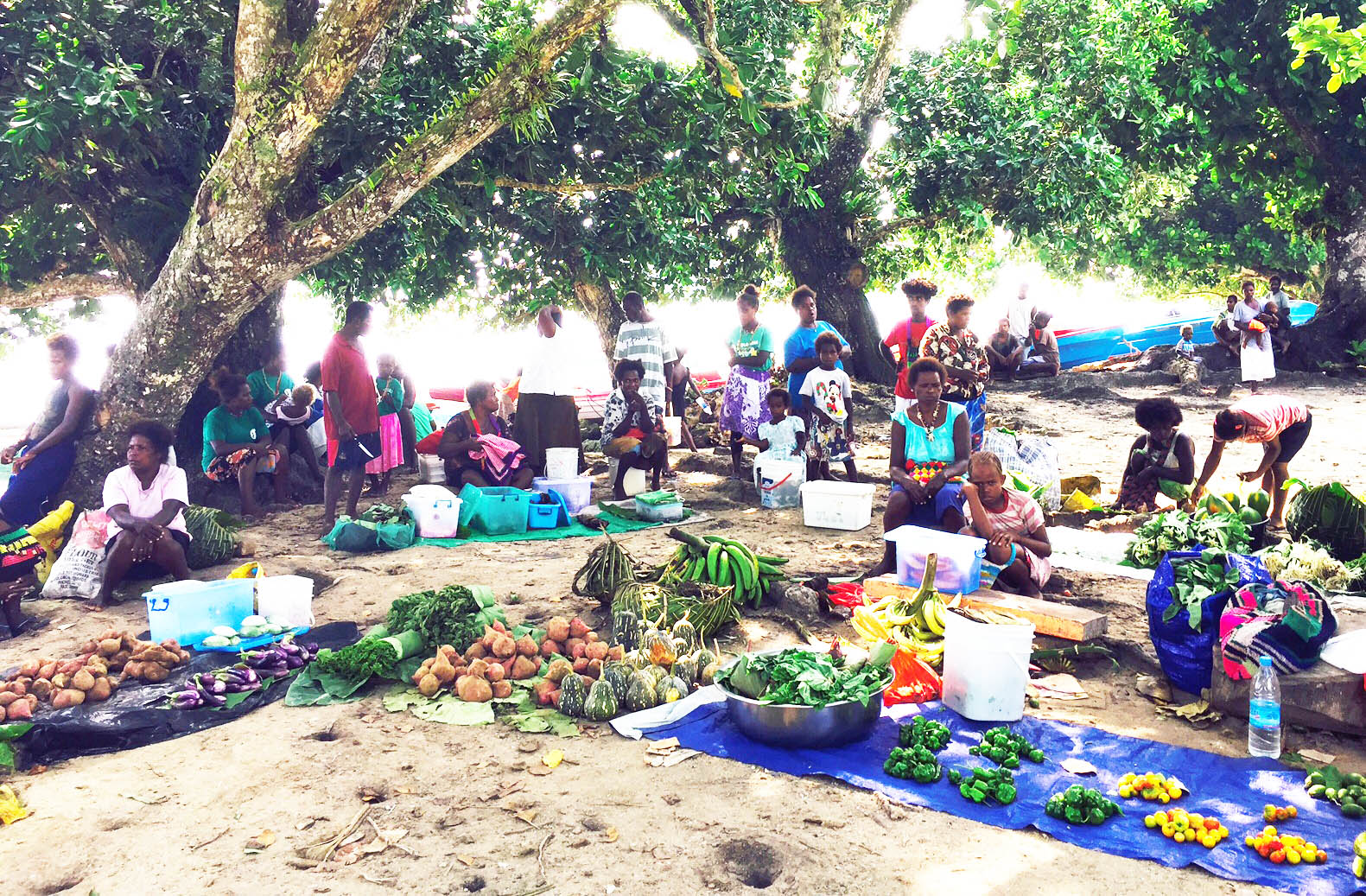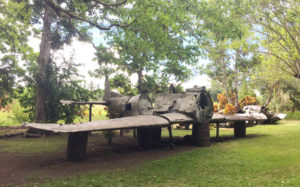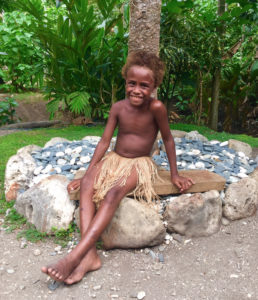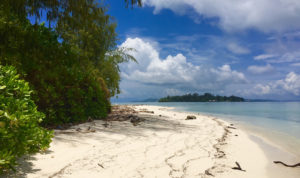Secrets of the Solomon Islands
By Julie L. Kessler
For World War II history buffs, the far away and often forgotten Solomon Islands are awe-inspiring. They are the place where U.S. marines fought and died on Guadalcanal. It is where young Navy Lieutenant John F. Kennedy saved his crew after their PT boat was cut in two by a Japanese destroyer. Reminders of the world’s deadliest struggle are never far away. Just swim a few dozen yards into the clear waters separating Guadalcanal and Florida Island and you’ll be in “Iron Bottom Sound,” the final resting place of dozens of U.S. and Japanese warships and airplanes.
The Solomons are a group of six large islands, 986 smaller ones and countless atolls forming a long archipelago stretching about 900 miles from Papua New Guinea in the north toward Fiji in the south. The British declared the Solomons a protectorate in 1893, mainly to avoid its annexation by France. The Japanese began occupying the islands in early 1942. Six months later, the U.S. Navy retook the islands after a month of savage fighting. The costly victory paved the way for later victories in Saipan, Iwo Jima and Okinawa.
The Solomons obtained their independence from Britain in 1978, but remain part of the Commonwealth. Today’s population is about 635,000, with 85-percent living in rural villages. Approximately 500,000 have no electricity. Malaria is still active here and education is not compulsory. As a result, the Solomons remain one of the South Pacific’s poorest countries.
Though English is the official language, just two-percent of the population use it. Most speak a Melanesian-based pidgin. About 95-percent are Christians, but their faith exist in delicate tandem with traditional ancestral beliefs.
Against this historical backdrop, I arrived at Henderson Field in the Solomons’ tiny capital of Honiara on Guadalcanal. WWII’s introduction is immediate as the airport is named after Major Lofton Russell Henderson, who died on June 4, 1942 when he led a flight of dive-bombers against the Japanese carrier Hiryū in the Battle of Midway.
After recuperating from the 20-hour flight from California at Honiara’s Heritage Park Hotel, I set out the following morning to see Iron Bottom Sound. After driving seven miles up the coast I stopped at Bonegi Beach, where just a few feet offshore sits the partially submerged Japanese transport ship, Kinugawa Maru. Being able to snorkel around Kinugawa in clear, warm water was incredible, because of ship’s sheer magnitude and the abundant marine life. Nearby is the Hirokawa Maru, another submerged transport ship, resting about 15 feet below the surface.
After briefly stopping for fresh coconut, I continued to the Vilu Outdoor WW II Museum. Situated on a large swath of land owned by Fred Kona’s family, the museum contains the remains of Japanese Betty Bombers, American Douglas Bombers, Grumman Wildcat F4Fs and the anti-aircraft guns that shot most of them down. All of the equipment was salvaged by the Kona family to prevent World War II history from being melted into scrap metal.
My last afternoon in Honiara was spent at the National Museum, which houses old spears, shell money displays and various bible texts translated into Pidgin and circulated by early missionaries. The day ended at the American Memorial, an outdoor tribute to fallen Allies felled during the Guadalcanal Campaign. Carved granite blocks outline the Campaign’s history from August 1942 to liberation in February 1943.
2017 is the 75th anniversary of the battle for Guadalcanal and the 100th anniversary of JFK’s birth, but students of history should leave plenty of time for sun, swimming and sand. I caught a 30-minute flight on a 1970’s Twin Otter to Marau on Guadalcanal’s eastern tip and walked from the grassy airstrip to a nearby dock. A 30-foot powerboat docked there sped me 15 minutes to Tavanipupu, a small island of 39 acres with 11 thatched huts and main dining pavilion. My oceanfront hut had an incredibly comfortable king-size bed with mosquito net, indoor and outdoor showers and a hammock-graced lanai.Tavanipupu gained notoriety in 2012 when royals Kate and William stopped here for a night. Locals insist Prince George was conceived here. Other destinations on the royal calendar also lay claim to the royal conception.
Visitors to Tavanipupu and the atolls near Marau enjoy bathtub-temperature water teaming with armies of clownfish, angelfish, starfish, groupers and seemingly endless corals. Once in the water I was surrounded by hundreds of vibrantly colored fish. The explosion of neon color was so intense, I felt as if I needed underwater sunglasses.
The next three days were a dreamy blur of crystalline snorkeling, kayaking and reading in the hammock with no radio or TV and, blessedly, only intermittent Internet service.
It’s easy to stay in Tavanipupu and just be. But the next day I took a boat ride to nearby Marairaro, an uninhabited atoll. I was only permitted to walk around one side of the atoll since I was told the other side is reserved for men from a nearby island who paddle canoes over to fish. Two other small, uninhabited atolls nearby, Tavairaro and Taaru, also are off limits to women.
Snorkelers and divers on the trail of Kennedy lore should fly to the Western Province capital of Gizo, the jumping off point for Kasolo Island – now renamed Kennedy Island – and Olasana.
At age 26, Lt. John F. Kennedy commanded PT-109, one of US Navy’s 15 Patrol Torpedo boats in the area. On August 1, 1943, toward the end of the Guadalcanal Campaign, his boat was struck during a nighttime attack on a Japanese convoy. JFK and his surviving crew spent the next few days swimming to various islets in the area under intensely strong current conditions. JFK was finally rescued with the assistance of two Solomon Islanders on Naru on August 7th and the rest of the crew on Olasana the next day. For JFK’s courage and leadership he was awarded both the Navy and Marine Corps Medals and a Purple Heart.
En route to Kennedy and Olasana consider stopping on Mbabanga Island for a brief stay at Fatboys, a comfortable hotel featuring five overwater bungalows that face Kennedy Island. Fatboys is the best hotel in this sector of the Solomons. The open-air dining pavilion and bar hover over Vonavona Lagoon where schools of brightly colored fish and at night black tip sharks glide through the turquoise waters.
Uninhabited Olasana, where Kennedy’s men took shelter beneath the dense trees, is much as it was in 1943. There was no fresh water at the time and the coconuts made many of his men sick. So JFK and George Ross swam to nearby Naru, where they found some Japanese candy, a tin of water, and in the bushes, a one-man canoe. Leaving Ross to rest, JFK took the canoe and candies to his crew on Olasana. He carved a message onto a coconut, which he gave to two islanders who took it to an Australian Coastwatcher. On August 8, 1943, a week after PT-109 sank, JFK and his crew were rescued and taken to the U.S. base on Rendova Island.
Near Olasana and Kennedy Island is a narrow strait, the Ferguson Passage with several atolls and sandbars that are home to coral, starfish and thousands of neon fish darting to nature’s inexplicable rhythm. Kennedy Island is shockingly small; exactly one hundred paces from east to west. No small wonder JFK feared being seen by enemy forces and swam to larger Olasana.
On my flight onward I pondered the swimming skills JFK acquired as a member of Harvard’s swimming team and the courage it took to lead his men to safety. His is a story that many Americans hopefully will discover when they visit the Solomon Islands on the 75th anniversary of one of the 20th Century’s bloodiest struggles. ![]()
Julie L. Kessler is a travel writer, attorney and legal columnist based in Los Angeles. She can be reached at Julie@VagabondLawyer.com





